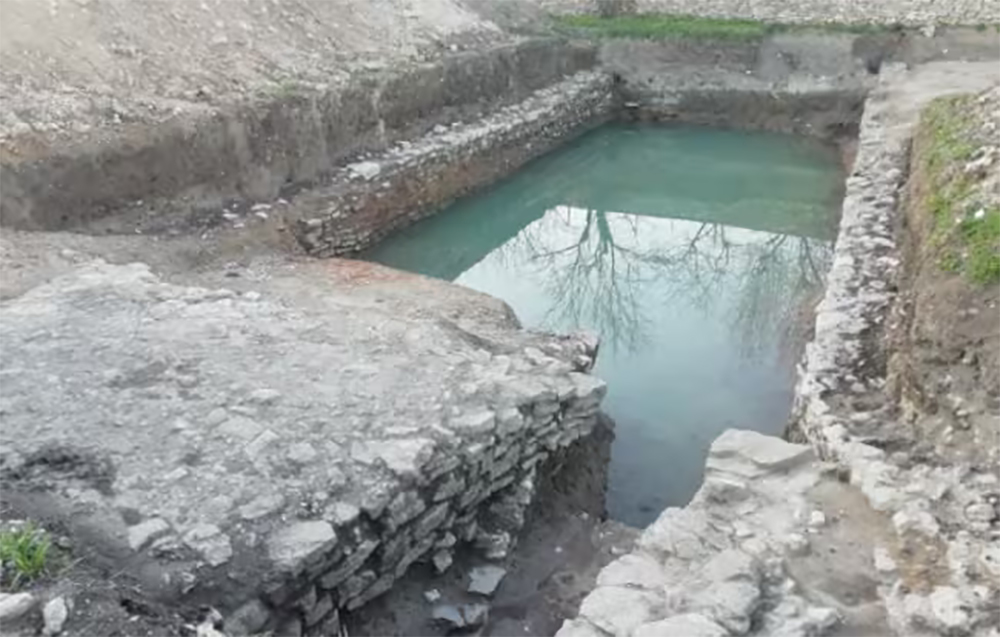More Roman remains have been found with aerial images, this time in Arkaia
- In the thermal zone of the Romans of Arkaia, a large hydraulic infrastructure linked to the Río Santo Tomás has been located, and an underground building of 3,000 square meters, with remains that could belong to a farm of that time.

After knowing last week the existence of a Roman circus at the site of Iruña–Veleia, the Provincial Council of Álava reported a new archaeological finding, according to EiTB. In the Roman city of Arkaia, in the so-called Suestatium, a well of water twenty meters long, eight meters wide and two meters deep has been found.
It is a unique infrastructure, since it is believed that it was built to channel and take advantage of the St. Thomas River during the flooding, indicating how far Roman engineering was going. In this way, it would serve not only to supply the city with water, but also to take advantage of the thermal baths of the city.
The archaeology of the company Iterbide, Miguel Loza, has detailed in more detail the Basque public television: "The St. Thomas River, especially in winter and spring, leaves its riverbed and therefore made a great channel to bring water to this organized city."

The Arkaia site has also been the subject of more findings. As in the Iruña Veleia site, with aerial images of drones and special techniques, they have inspected the surrounding subsoil of the city and believe that there could be remnants of a building of about 3,000 square meters. Sources have pointed out to EiTB that it may be a school, an apple or a "stop" from the road between Astorga and Bordeaux.
People lived in the city of Suestatium from the 1st century to. C. until the 3rd century d. C. and it is known at least the existence of new houses of bathroom or baths since the 18th century. However, the city is barely excavated, although it has more than 20 hectares, only 1% or 2%.
Aranzadi Zientzia Elkarteko Etnografia Sailaren zuzendari berria da Maite Errarte Zurutuza (Beasain, 1995), urrian Fermin Leizaolaren lekukoa hartu ondoren. Kultura materiala aztertzen jarraitzeko beharra azpimarratu du, gizartearen memoria eta bizimodu aldaketak erregistratzeko... [+]
Atapuercako aztarnategian hominido zahar baten aurpegi-hezur zatiak aurkitu dituzte. Homo affinis erectus bezala sailkatu dute giza-espezieen artean, eta gure arbasoek Afrikatik kanpora egindako lehen migrazioei buruzko teoriak irauli ditzake, adituen arabera.
Martxoaren 30erako Iruña-Veleia martxan, SOS Iruña-Veleia eta Euskeraren jatorria elkarteek manifestaziora deitu dute, Aski da! Argitu, ez suntsitu lelopean. Azken bi urteetan "hondeatzaileak sistematikoki eremu arkeologiko oso aberatsak suntsitzeko modu... [+]
Ethiopia, 24 November 1974. Lucy's skeleton was found in Hadar, one of the oldest traces of human ancestors. The Australian hominid of Australopithecus afarensis is between 3.2 and 3.5 million years old.
So they considered it the ancestor of species, the mother of all of us. In... [+]
While working at a site in the Roman era of Normandy, several archaeology students have recently made a curious discovery: inside a clay pot they found a small glass jar, of which women used to bring perfume in the 19th century.
And inside the jar was a little papelite with a... [+]
A team of researchers led by the Japanese archaeologist Masato Sakai of the University of Yamagata has discovered numerous geoglyphs in the Nazca Desert (Peru). In total, 303 geoglyphs have been found, almost twice as many geoglyphs as previously known. To do so, researchers... [+]
Treviño, 6th century. A group of hermits began living in the caves of Las Gobas and excavated new caves in the gorge of the Laño River, occupied since prehistory. In the next century, the community began to use one of the caves as a necropolis. In the 9th century they left the... [+]
On August 1, a dozen people from the family were in Aranguren. Two young people from Aranzadi made firsthand the excavations and works being carried out in Irulegi. This visit is highly recommended, as it reflects the dimension of the work they are doing.
Halfway, at the first... [+]
In the desert of Coahuila (Mexico), in the dunes of Bilbao, remains of a human skeleton have been found. After being studied by archaeologists, they conclude that they are between 95 and 1250 years old and that they are related to the culture of Candelaria.
The finding has been... [+]
The Roman city of Santakriz is an impressive archaeological site located in Eslava, near Sangüesa. Apparently, there was a fortified people of the Iron Age, and then the Romans settled in the same place. Juan Castrillo, himself a priest of Eslava, gave the site for the first... [+]
This winter the archaeologists of the INRAP (National Institute of Preventive Archaeological Research) have found a special necropolis in the historic centre of Auxerre (French State), a Roman cemetery for newborn babies or stillbirths. - Oh, good! The necropolis used between... [+]





















